A Forgotten Type of Poolish, Pouliche (Sponge) Loaf

In the last post here, I said since the experiment with the poolish showed signs of activity it had inspired for more experiments, only this time not exhausting the yeast to see whether I could produce a good loaf.
A poolish is equal amounts of water to flour, how much yeast you add and the temperature it’s kept at will determine how fast it rises. Usually you see a poolish sit anything from 6-12 hrs.
Bacterial Growth
The idea of a poolish (like with any other preferment) is to enhance bread flavour. The long fermentation of the poolish contributes by allowing time for enzyme activity, and something else which is never spoken of is allowing bacterial growth. Yeast doughs fermented for 8 hours or longer will have bacterial activity, this is what I believe contributes to a better flavour in long fermented yeast doughs. In fact you can manipulate with certain flours or pre-long the length of time with the poolish to the extent it will add acidity to the finish crumb just as you do in a sourdough, only in a milder form.
The other contributing factor of a poolish is shortening the time it takes for the baker to make the bread.
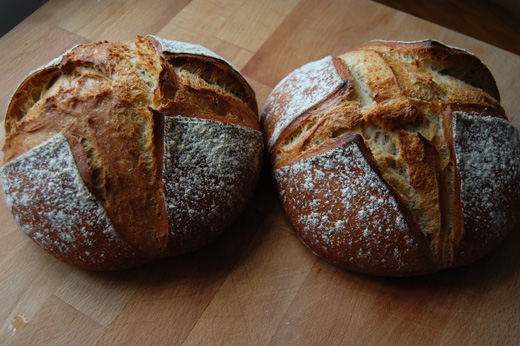
Why Are All Poolish Recipes the Same?
What’s interesting when I started experimenting with this type of poolish was how I hadn’t seen it written elsewhere. All my bread books when using a poolish they add more yeast on mixing the dough. Did you notice in my last post how I had omitted adding any extra yeast when it came to making the dough? This was the amazing discovery for me, that almost-dead-but-not-quite loaf was showing signs of activity.
I checked my bread books recipes using a poolish and all added yeast twice, a tiny amount for the poolish and again a larger amount mixing the poolish with the rest of the flour. Why? Why add yeast again? Can a dough not be made with just the yeast in the poolish? A tiny amount of yeast will still have thousands and thousands of yeast cells, isn’t that enough? Made me wonder if they knew something I didn’t. I wanted answers.
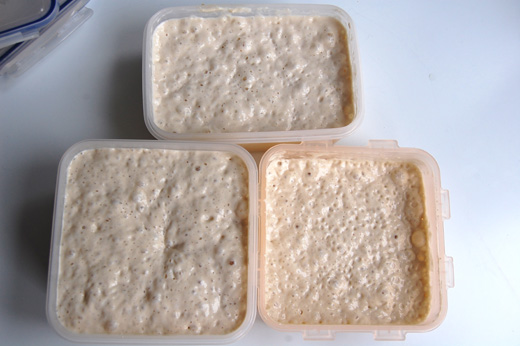
Above on the very top a sourdough levain, isn’t it interesting how it looks the same as a yeast version?
Underneath the levain, two different size poolish, one box has a larger amount (of equal amounts of flour/water ) to the other box.
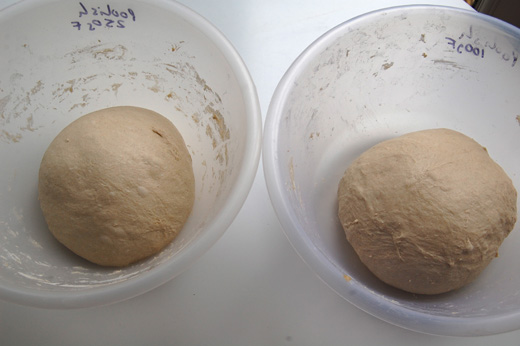
If you remember in the last post I had mixed the poolish the night before 100g flour / 100g water, large pinch of yeast, and that’s how I made the dough on the right, the same as last time.
On the left I mixed a larger portion of flour/water for the poolish but same amount of yeast.

Mix the doughs, rested, folded once, short rest, shaped, short prove. bake.
Both have same amount of white roller mill flour to white stoneground.
Not surprising the dough on the left with the larger portion of poolish in the dough held together better and performed better.
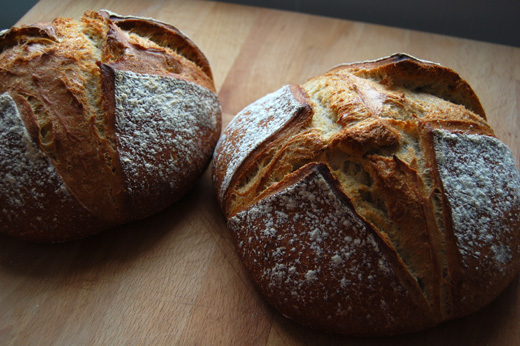
Surprisingly, they both came out looking similar it was hard to tell them apart.
I score them the same to make sure there wouldn’t be differences in the oven-spring.

It was on seeing the crumb it was visible which loaf had the larger portion of poolish, the right, a more open aerated crumb.
Easier to see it close up below.

The crumb below from the smaller amount of poolish in the dough, showing signs of density, closed tight areas with no signs of air or carbon dioxide. And it tasted as it looked, denser than the other.

The Crumb of A Good Poolish
What was interesting was how the texture of a yeast dough like this resembled the waxiness and chewiness of a sourdough.
Because of the amount of stoneground flour mixed in it also had great flour, making it the tastiest yeast loaf I’ve had (without being enhanced by nuts/olives/seeds or such like).
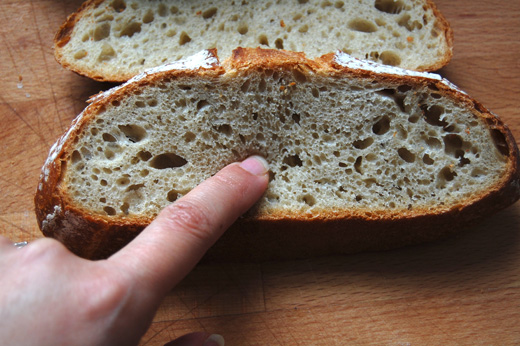
Poolish With All White Rollermill Flour
I was on a roll with this poolish experiment.
I could now successfully produce a poolish loaf without adding any extra yeast on mixing the dough. I wanted to know how much flavour a poolish could produce using the dullest flour, 100% white roller mill.
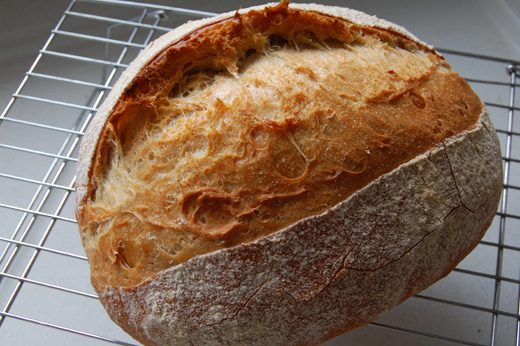
I increase slightly more the amount for the poolish in this loaf.
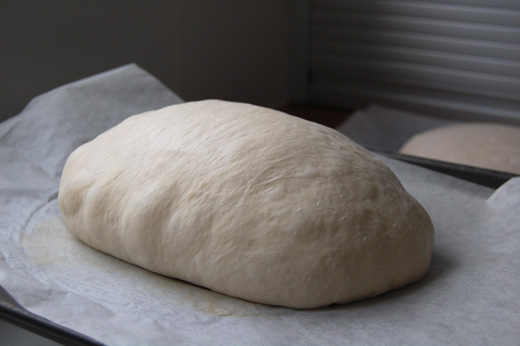
The mixing, resting and folding I followed same as the loaves above.
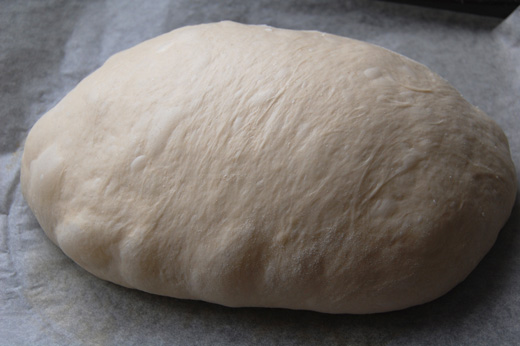
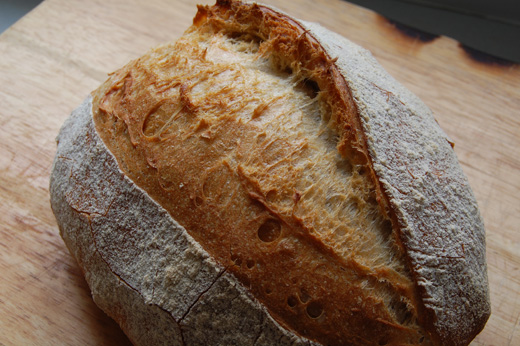

Taste of Poolish With 100% Rollermill Flour?
Well, it was lacking the flavour the other loaves had. What can I say about white roller mill flour other than it’s fantastic for performing all sorts of things with it but it lacks depth of flavour.
It tasted of a nice yeast loaf, difficult to satisfy a sourdough baker and therefore I’m always going to judge it with a hint of sourdough prejudice.
Where it excelled was the texture, it was good and chewy, to the point Allergy Kid noticed it and disliked it, if you don’t already know this this is the kid with a love for supermarket bread.
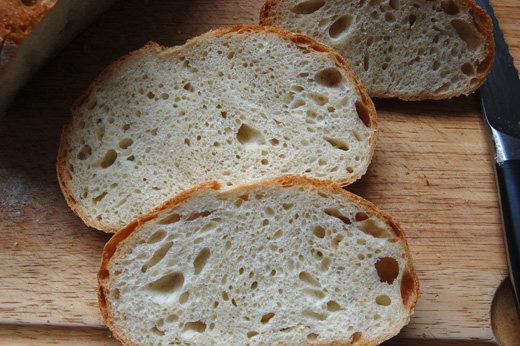
Old Fashion Poolish
Remember my questions above as to why did all recipes in my bread books for a poolish added yeast twice?
As you can see through my experience there is no need for the second addition of yeast.
I’m guessing the reason the second larger fix of yeast is added is to absolutely guaranty performance just in case the poolish has been left to over-ripe and is exhausted, as I’ve shown with these experiments it can happen.
Nothing in bread is new, we have been baking for thousands of years including yeast loaves, so surely this poolish method is old?
I turned to baker friend Paul Merry who’s a great fountain of knowledge with all sorts of traditional methods. Paul indeed confirmed this is an old method of making dough.
A conversation about this with Anne from Felin Ganol mill led to her checking in the only book I hadn’t looked through properly, Elizabeth David’s English Bread and Yeast Cookery, page 107, Dough-mixing on the quarter-sponge system. Elizabeth writes the recipe of a Walter Banfield’s formula using a tiny amount of yeast 0.13%, (baker’s percentage) and the recipe involves 3 stages, unlike the 2 stage method used here. 0.13% of yeast is a tiny amount, mine uses 0.2% of yeast.
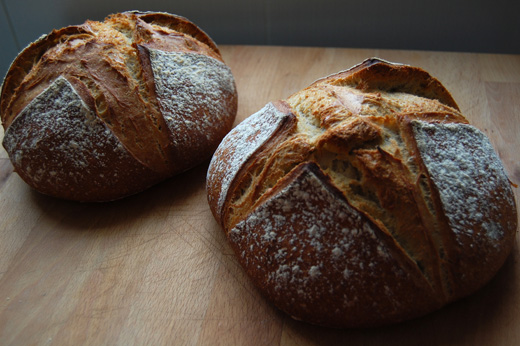
Why I Love This Old Sponge Method
When discovering I could bake using only the yeast from the sponge I became as excited about making yeast loaves as when I first discovered sourdough.
I made poolish recipes last year when working in the cafe, using Jeffrey Hamelman’s formulas of adding the extra yeast, it was good for me as the baker to cut down on the process time but it contributed nothing to the taste of the bread, for this reason I never re-visited this method from a flavour perspective.
I can see from this method however adding a little stoneground or high extraction flour to the poolish would help the microorganism to acidify the dough a little, enhancing the flavour of the finished crumb. And as I’ve said with the top loaves, mixing in white stoneground flour also made a good tasting loaf in a really quick time.
Adding the extra yeast when mixing the dough adds nothing to the flavour, the least yeast added the better chance of a good flavour you’ll be able to achieve. If you don’t believe me, next time over-dose your dough with yeast and see how that yeasty-flavour tastes?
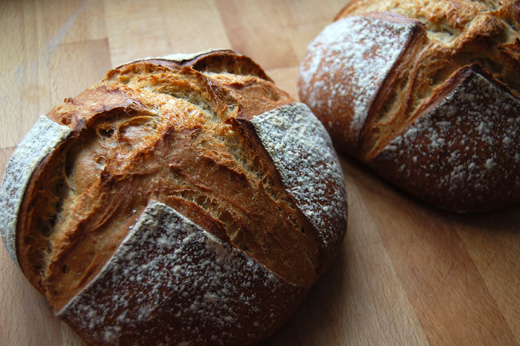
Long fermented yeast doughs with some type of preferment have developed plenty of enzyme activity, shortening the time on making the loaf as well contributing to flavour. This time creates an environment for bacterial growth and they contribute towards some gluten breakdown and the raising of the acidity levels. All of this will result in the characteristics of a good tasting loaf.
The other aspect lost with adding extra yeast is the loss of chewy texture crumb the poolish microflora worked so hard to create.
This turned out to be one of the most exciting experiments I’ve baked. I’m a convert to this old fashion poolish with yeast dough. It’s a fantastic way to make a quick and very good yeast loaf the next day with the minimum amount of effort, only adding a pinch of yeast to some flour and water before going to bed. The dough the following day was ready for baking within two hours.
Yesterday I played around with the poolish further and produced a yeast loaf with some mild tang, will post about it.
Note:
After posting this on Facebook Universal page Jim Chevallier the author of About the Baguette: Exploring the Origin of a French National Icon, a book I’m halfway through reading and would recommend it it’s full of interesting French bread facts, posted some old poolish recipes written from 1902 following the same principals I write about here.
And it transpires the original word for poolish is in fact spelt pouliche.
